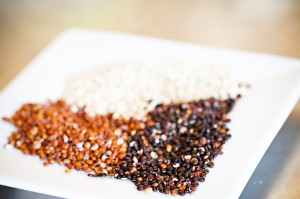How to Grow a Broccoli Lover: Teaching Babies to Like Vegetables
 One of the most popular baby food flavors at Little City Kitchen Co. is swiss chard and kale with caramelized onions, apple and white sweet potato. Kids eat chard? Really? I talk to parents all day at the farmers market, and one of the most frequent statements I hear is “My kid doesn’t like _____”. Typically they fill in the blank with a green vegetable like broccoli or green beans.
One of the most popular baby food flavors at Little City Kitchen Co. is swiss chard and kale with caramelized onions, apple and white sweet potato. Kids eat chard? Really? I talk to parents all day at the farmers market, and one of the most frequent statements I hear is “My kid doesn’t like _____”. Typically they fill in the blank with a green vegetable like broccoli or green beans.
Which begs the question: Can you teach food preferences, or do babies already know what they like and don’t like?
I recently had the honor of attending the first annual Childhood Obesity Conference hosted by Slow Food San Francisco. You may know one of the keynote speakers, Dr. Alan Greene, author of Feeding Baby Green and creator of the WhiteOut initiative that calls for a ban on baby white rice cereal.
My long-time readers know that I’m honest to a fault, so while I was familiar with the book Feeding Baby Green, I must now confess that I picked up the book for the very first time last week and sorta “crammed” for the conference – sorry Dr. Greene! Imagine my surprise that nearly every philosophy and conclusion that I came to through my own research (with the help of experts like pediatricians and nutritionists) was echoed and even expanded upon in this wonderful book.
So back to baby’s food preferences…can they be learned? YES!
Why is it important to expose your kids to a variety of foods at an early age? Because you’re setting them up for a lifetime of healthy eating. You have a distinct window of opportunity when they start solids to teach them to love a variety of flavors. Once they start walking, that window closes and they rely on what they’ve been taught so far to carry them throughout toddler-hood and the rest of their life.
Dr. Greene talks about the key word to introducing new foods is patience, and to that I would also add the word persistence. If you keep those two words in mind, you’re likely to have a drama-free feeding experience and a healthy eater in the end.
Three small steps that parents can take:
- Involve baby in the new food ahead of time. Let them feel the avocado skin, squeeze the cooked sweet potato in their hands, watch you chop up the green beans before you feed it to them. Getting them familiar with flavors and aromas will help them be more accepting of those foods.
- Eat these foods yourself for dinner. Kids will naturally want what’s on mom or dad’s plate, so if you eat the same foods, they’ll be more apt to try them themselves.
- And the most important one: Try new foods 7-15 times before allowing baby to make up her mind. Just a spoonful a day needed, once a day, for at least a week. No need to force it, just try again the next day if they aren’t interested. You’ll be surprised when all of a sudden they gobble up the swiss chard they’ve been refusing for days!
Yup, you too can grow a broccoli-lover! Please feel free to leave a comment below about your own experiences with getting kids to eat less-common whole foods!
Birth & Baby Fair
 And just a reminder, Little City Kitchen Co. will be at the Birth & Baby Fair this Sunday at Fort Mason from 10-4pm. We’ll be leading another baby food cooking demo that day at 3pm, and you can pre-register here to reserve your seat. Hope to see you there!
And just a reminder, Little City Kitchen Co. will be at the Birth & Baby Fair this Sunday at Fort Mason from 10-4pm. We’ll be leading another baby food cooking demo that day at 3pm, and you can pre-register here to reserve your seat. Hope to see you there!




